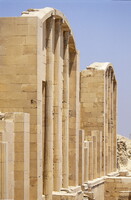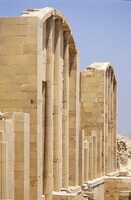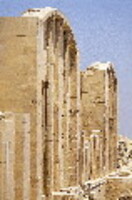| dc.coverage.spatial | Site: Saqqara, Desert, Egypt | en_US |
| dc.coverage.temporal | ca. 2630-2611 BCE (creation) | en_US |
| dc.creator | Imhotep | en_US |
| dc.date | -2639--2611 | en_US |
| dc.date.accessioned | 2013-04-23T17:36:44Z | |
| dc.date.available | 2013-04-23T17:36:44Z | |
| dc.date.issued | -2639--2611 | en_US |
| dc.identifier | 209888 | en_US |
| dc.identifier.other | archrefid: 753 | en_US |
| dc.identifier.uri | http://hdl.handle.net/1721.3/117913 | |
| dc.description | View of symbolic chapels on the north end on the west side of the Heb-Sed Court, profile view; Saqqara is an Egyptian site on a desert plateau about 20 km south of Cairo and just west of the ancient city of Memphis, which flourished as a necropolis and religious centre in the Dynastic, Late and Greco-Roman periods. In the Coptic period it continued in use as a monastic centre. The most important structure of the Early Dynastic period, however, is the funerary complex of Djoser [Djoser, Zoser, Netjerikhet, ca. 2630-ca. 2611 BCE, first ruler of the 3rd dynasty], which marks the first appearance of monumental stone architecture in Egypt. Its central element is a massive stepped pyramid (140 x 118 x 60 m); of limestone masonry. The complex is surrounded by a recessed limestone wall with bastions and 14 imitation closed gates enclosing an area roughly 300 x 500 m. The single genuine entrance in the south-eastern corner leads into an entrance colonnade comprising 48 ribbed columns. The southern massif of the enclosure conceals a structure known as the 'Southern Tomb' which includes a shaft, a burial chamber, further rooms decorated in blue faience tiles and three more stelae depicting Djoser. It may represent the King's southern cenotaph, where the canopic vessels holding his viscera would have been deposited. Other significant buildings include the 'House of the North' and 'House of the South', which may represent the shrines of Upper and Lower Egypt, and a court lined with dummy chapels intended for the symbolic celebration of the royal jubilee (heb-sed ) festival. Although they were built of stone, these chapels imitate the forms of Predynastic and Early Dynastic structures of brick, wood and reeds and thus represent a transition between the use of organic materials and the development of stone architecture. Source: Grove Art Online; http://www.groveart.com/ (accessed 1/15/2008) | en_US |
| dc.format.medium | stone | en_US |
| dc.rights | © Scott Gilchrist, Archivision, Inc. | en_US |
| dc.subject | architectural exteriors | en_US |
| dc.subject | death or burial | en_US |
| dc.subject | rulers and leaders | en_US |
| dc.subject | Djoser, King of Egypt | en_US |
| dc.subject | Egypt--Civilization | en_US |
| dc.subject | Egypt--Religion | en_US |
| dc.subject | Early Dynastic (Egyptian) | en_US |
| dc.subject | Third Dynasty | en_US |
| dc.subject | Old Kingdom (Egyptian) | en_US |
| dc.title | Funerary Complex of Djoser | en_US |
| dc.title.alternative | Complex of Djoser: Step Pyramid and the enclosure | en_US |
| dc.title.alternative | Funerary Complex of Zoser | en_US |
| dc.type | image | en_US |
| dc.rights.access | Licensed for educational and research use by the MIT community only | en_US |
| dc.identifier.vendorcode | 1A3-EG-SQ-1-K2 | en_US |
| vra.culturalContext | Egyptian (ancient) | en_US |
| vra.technique | construction (assembling) | en_US |
| vra.worktype | pyramid (tomb) | en_US |
| vra.worktype | temple | en_US |
| dc.contributor.display | Imhotep (Egyptian (ancient) architect, ca. 2630-ca. 2611 BCE) | en_US |


